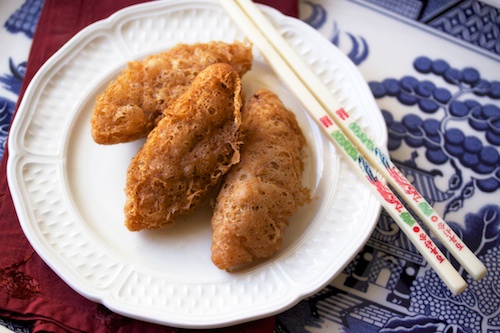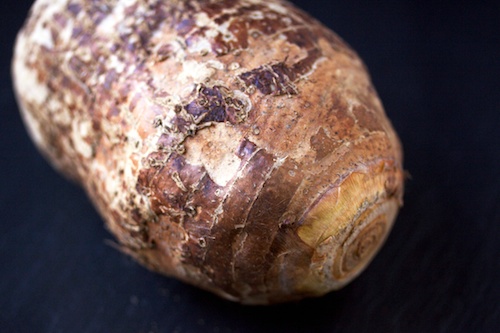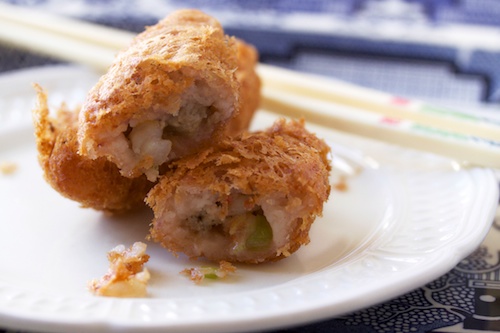Despite certain appearances to the contrary (Slow Food-ishness, Southern accents, surrounding areas stuffed with gun-toting reactionaries), Gourmandistan is a place that embraces Progress. While we’ve seen that bitterly clinging to the past certainly brings its share of disappointments to some, we know anticipating the future can be dicey as well. (Steve, for one, still remembers 1997 as the year he didn’t get his atom-powered convertible chariot.) Recently, at the Roger Smith Cookbook Conference that Steve attended in New York City, several panels bravely tried to face the coming century with topics such as “Cookbooks vs. Digital Media,” “App Development and Marketing” and “Trendspotting in the Food Space.” Steve, whose cookbook plans (if any) are far into the unknown future, passed up most of the media education in favor other panels. Aside from attending events, of course, he ate—once at Mission Chinese NYC with Daisy, and twice at Nom Wah Tea Parlor. The nicely-prepared dishes at Nom Wah furthered Gourmandistan’s fever for homemade dim sum, fueled as well by Steve’s finding wheat starch and good dried shrimp in Chinatown.
Once Steve was home, we fired up Gourmandistan’s first Kindle cookbook, the “Enhanced Edition” of Asian Dumplings by Andrea Nguyen. Despite the grumblings of some older would-be authors at the conference (“I’ve never seen a good app for a cookbook in my life” said one gravelly-voiced woman as Steve waited for an elevator), Asian Dumplings has shown us just how handy electronic cookbooks can be. The print edition would undoubtedly be very good itself: Nguyen’s directions are clear and helpful, and the book is full of dumpling history and hints. But having video demonstrations of dumpling techniques available as one holds a sticky ball of taro dough, plus immediate links to online sources for bamboo steamers and Asian ingredients, can be amazingly helpful. Yes, the iPad’s touchscreen can get a little greasy, especially when handling lard-laced dough, but it cleans up fine.
We’ve tried several recipes from Asian Dumplings, but the clear winner so far has been these Taro Puffs, a dish that’s disappointed us in dim sum parlor after dim sum parlor. Nguyen herself describes the experience of dumplings that are “lackluster and leaden” by the time they are picked off the cart. These, however, are light and lovely, their delicately crisp exterior crunching into a creamy dough holding seasoned pork and shrimp.
We have no idea where the future will find the cookbook, being as the entire process of cooking could very well be replaced by robots, robots or worst of all, robots. But while we’ll still most likely buy print-based books (Michelle loves to make notations, as well as read notes from previous owners), we do see our near future including more electronically-enhanced cookbooks. Unfortunately for dim sum parlors across the globe, though, the future will also most likely include fewer visits from us. Our standards have become much higher.
TARO PUFFS (WU GOK)
(adapted from Andrea Nguyen’s Asian Dumplings)
Filling:
- 3 oz. ground pork
- 1 t. soy sauce
- 1 t. minced fresh ginger
- 3 oz. shrimp, peeled and deveined
- Salt
- Pepper
- Pinch sugar
- 1 t. cornstarch
- 1/2 t. sesame oil
- 1-1/2 t. oyster sauce
- 1 t. sherry
- 1 TB water
- 1 TB canola or peanut oil
- 2 or 3 scallions, white and green parts, chopped
Combine pork, soy sauce and ginger in a small bowl.
Toss shrimp with a pinch of salt. Rinse. Drain well and dry with a paper towel. Chop fine.
In a small bowl, mix together another pinch of salt, a grind or two of pepper, sugar, cornstarch, sesame oil, oyster sauce, sherry and water. Stir.
Heat oil in a small skillet. Add pork. Stir, breaking up pieces with a spatula, until cooked through. Add shrimp, tossing with spatula, until cooked. Add sauce mixture, stirring. Remove from heat and add scallions. Transfer to a small bowl and cool, then refrigerate for several hours.
DOUGH:
- 1 large taro root (3/4 to 1 lb.)
- 1/3 c. wheat starch*
- 1/3 c. boiling water (approximately)
- Pinch salt
- 1-1/4 t. sugar
- 1/4 c. lard or solid vegetable shortening, at room temperature
Peel taro root, removing tough outer layer of flesh along with the peel. Chop into 1″ to 2″ square pieces.
Steam taro over boiling water for 30-45 minutes, until soft.
While taro is cooking, put wheat starch in a bowl. Gradually add the hot water, stirring with a wooden spoon. Stop adding water when the mixture resembles frosting. Set aside, covering if it begins to dry out.
Let taro cool for about 5 minutes, then place in a clean bowl. Mash with your fingers, discarding any hard pieces.
Place about 1/2 pound (1 cup) of the mashed taro in the bowl with the wheat starch mixture, along with salt and sugar. Mix with your fingers until blended. Then work in lard or shortening, kneading for a couple of minutes until the dough is the texture of mashed potatoes. Gather dough into a ball, wrap in plastic wrap and refrigerate for at least 2 hours.
ASSEMBLY:
Line a baking sheet with waxed or parchment paper.
On an unfloured work surface, roll dough out to a 12″ log. Cut into 12 equal pieces, then roll each into a ball. Chill dough balls for at least 15 minutes.
Remove dough balls from refrigerator one at a time. With your hands, flatten ball into an oblong circle, then make a “bowl.” Add a rounded teaspoonful of filling to the center of the dough, flattening it a bit with your fingers. Bring up the sides of the dough over the filing, forming sort of a “football” shape. Pinch the dough sides together. If holes form in the dumpling making the filling show through, patch with some of the extra dough from the ends. Place dumpling on the prepared baking sheet, then proceed to form the remainder. Refrigerate.
FRYING:
Pour at least 1-1/2″ of canola or peanut oil in a small saucepan with deep sides. Heat oil to 360-370° over medium-high heat. (You really need a thermometer here, as, if the oil is not hot enough, the dumplings will fall apart.) Fry dumpings 2 or 3 at a time. When dumplings are placed in the pan, the oil will boil up. As soon as the dumplings begin to float, turn the heat down to medium-low. If they stick together, separate gently with a slotted spoon. When dumplings are browned, after 2-3 minutes, remove with a slotted spoon to a cooling rack placed over waxed paper (or drain on paper towels).
Serve hot (best) or at room temperature.
*Wheat starch (also known as tang mein flour, dim sum flour, wheaten cornflour and tung mein fun) is a necessary ingredient in many dim sum recipes. We’d tell you it’s available at most Asian markets, but that hasn’t been our experience. In fact, despite extensive research, we’ve only found 2 tiny bags of the stuff in all of Louisville and lack the foreign language skills to ask that more be ordered. The problem may be that most of our Asian markets are either Vietnamese- or Korean- rather than Chinese-owned. If we don’t find more wheat starch soon, we’re going to have to plan another trip to a city with a real Chinatown.




Ah! This is always my favorite to get when we go out for dim sum, but I never knew what it was called or how it’s made. Now that I’m enlightened, making these in my kitchen is a thing that will happen very soon!
It was a revelation to me, too. I knew I liked them a lot, but I had no earthly idea how they were made.
I’ve not been out for dim sum in ages and I do miss these puffs. I applaud you for tackling the recipe and making your own. You’ve really tempted me to try to make these but, honestly, I think it more likely that you’ve just convinced me to get a couple friends together and head to ChinaTown for some dim sum. 🙂
That’s fun, too!
I love that book! I’ve made many of the recipes, but not this one! Sounds very intriguing. Thank you
Have you had any luck with the har gow type doughs? We’re struggling a bit with those. But it’s a great cookbook.
I only tried the vegetarian crystal dumplings once, and it was quite a disaster. They ended up being tasty and somewhat transparent, but the dough was impossible to deal with. I haven’t attempted it again so far, so I don’t know if the problem is me or the recipe. I do have another recipe for har gao dough, so if I ever get more satisfying results, I’ll definitely let you know!
They look great. My eye, however, was taken by the name “gok”. There is a nightmareish trend setter on UK TV by the name of Gok, who comes over as a bit of a puff too.
We saw him hosting a terrible dating show on British satellite TV when we were in Normandy. The “gok” puffs are definitely better!
This used to be one of my favourite snacks, until I got food poisoning after eating one and spent a night throwing up. I wonder if I could eat one now that a few years have passed…
I have the same problem with oysters after a similar experience in Paris years ago. But I never liked them all that much, so I don’t mind it as much as I would mind missing these!
I’m still waiting for that chariot too, but I’d settle for the robot – that was my favourite show in the 60’s.
Those puffs look fantastic and worth all the effort. I have occasionally had very good ones, on Saturday lunchtimes, when the dim sum restaurants are full and the stuff coming from the kitchen is fresh and doesn’t stay on the trolley for long 🙂
I loved Lost in Space!
Beautiful. Worth the work, though? (I’ve found that, with the exception of lotus-wrapped sticky rice and maybe scallion pancakes, the result in homemade dim sum has never been worth the exhaustive effort.)
It does take a bit of prep time, what with having to cook and cool the taro, etc. But feathery crisp outside and hot, creamy and delicious inside? Well worth the effort!
Now I can make it thanks to this recipe, one of my favorite yamcha dishes
They’re among my favorites, too. Though I’m really spoiled now.
Beautiful looking puffs. Well done Gourmandistan. I might come to live there.
Best,
Conor
We have a very liberal immigration policy. 🙂
I am going to give this recipe to my husband, he will make these for sure! great.. c
Excellent idea!
I truly miss this. We are having Dim Sum on Sunday and sadly, I can only have a few things at the restaurant since I am gluten free. My MIL can make this among other things and is amazing cook. Your recipe looks fantastic. I wish I could eat this. But, wheat starch is what brings it together…and I read that cornstarch doesn’t quite cut it.
Yeah, I think wheat starch is what gives the crusty outer shell. 😦 Thank goodness there are some gluten-free items on the carts though.
Those look perfectly delicious! And that cookbook is one of my favorites. Even though I too prefer print, I’m going to have to check out the “Enhanced Edition” sometime just to compare…
I love the real books. (She says as she trips over one of the many scattered throughout the house…)
Taro, wonderful stuff, n’est-ce pas? Okay, you’ve convinced me–this is the second great recipe I’ve seen in your blog from this book. I’m ordering it today. By the way, when I bought my iPad last year the guy in the Apple store said the number one selling accessory (after a cover) was a magnetic refrigerator mount. I think media cookbooks are going to be big. Ken
The thing I hate about e-books is that you can no longer go in somebody’s house and size them up immediately by scanning their bookshelves! I’m a convert now, though, at least with regular books, because of the ease with which one can travel with a whole library. Cookbooks, though? I don’t know. I may actually buy the dead tree version of this cookbook, too.
I love ebooks, but I recently came up against two downsides: 1) If you’re travelling you have to deal with the damn “turn off all electronic devices, including ebook readers” (direct quote) dictum. If, as happened to us, you end up delayed getting off the ground, or circling while a runway clears, you’re stuck, while everyone else around you with an ordinary paperback keeps on ticking; and 2) there’s a body of recent evidence suggesting that exposure to illuminated screens (not my Kindle, but yes for my iPad) before going to bed disrupts melatonin production, which means that while you may fall asleep, you don’t stay asleep as long as you should. However, since I don’t cook immediately before going to be, I’m going to get the dumpling book in its digital version. Ken
Interesting about (2)—I hadn’t heard that. And re (1), for sure, it’s definitely a good idea to take extra backup stuff like crossword puzzles to deal with the crazy airplane rules. There are only so many times one can flip through the SkyMall catalog without going insane!
These look and sound wonderful, as do Steve’s meals in NYC with the inimitable Daisy. I applaud you for having the courage to tackle these.
They were soooooo delicious. Exactly what one always wished would come off the cart, but didn’t quite. (And, around here, didn’t even come close…) Yes, they had such fun—I believe I’m due a good trip! As it is, Steve conquered wheat starch dough today, so I see lots more great homemade dim sum in our future!
Absolutely! I am finally getting through my backlog of posts. Many apologies for joining the conversation so late! But yes, we missed you Michelle! A trip to NYC is due soon . . . aren’t you guys running out of wheat flour? 😉
Just kidding. In-between trips, don’t hesitate to ask me to send you more!
We found 2 little bags of wheat starch here on the floor of one of the scariest groceries I’ve ever been to. (Scary because the aisles were so narrow and the shelves so tall!) When it is gone, we may have to make plane reservations!
Definitely!!!
I like the look of these very much, so the recipe is most welcome. I shall be able to refer to it as I prop my ipad up on my kitchen counter. I love the iPad for cooking, but mostly because it makes blogged recipes easy to find and follow. With a vast resource of every possible recipe at my finger tips, I’m not sure I’d use a cookery ebook.
Physical books on the other hand – as well as being objects of beauty – are great for thumbing back and forth without regard for screens and buttons. My favourite books are those covered in dried out curry pastes and random oily splatters. They’re a great way of marking my favourite recipes with a sort of patina…
Well said! Thanks for stopping by.
The look of your wu kok is divine. I love this stuff. Applause to you for tackling this recipe. It looks hard.
It’s more time-consuming than difficult. And worth every minute!
Looks wonderful! Wu gok is one of my favorite dim sum dishes, but I bet yours were the best ever. Never tackled it before because I was afraid that they would be incredibly fiddly. But it actually looks okay! Bravo, you two!
There’s something so therapeutic about thumbing through print cookbooks (and when it comes down to it, I suppose the photographer in me just likes looking at the pretty pictures!) It doesn’t matter if I’ve flipped through a book a hundred times, I’ll do it a hundred times more with pleasure…
Pingback: Guest Post from Gourmandistan: Florentine failure begets brilliant bollito baguette | Katie at the Kitchen Door
This is one of my favourite dim sum dish! Definitely trying this soon.
They’re my favorites. At least until the next cart comes by. 🙂
Pingback: Taro Puff | Domestic Urbanite
These puffs look – and sound – great, Michelle.
good Puff i like it this Recipes
With this recipe, will.the outside be crispy like in the photo? Or is there a batter recipe missing?
The wheat starch makes the outside crispy. No batter needed.
Pingback: The Best Taro Root Dumplings Recipe | Dim Sum Central
These puffs look delicious. Crispy to perfection! Great post.
Pingback: The Best Fried Sticky Rice Recipe | Dim Sum Central
I was wondering if I could just sub APF for the wheat starch. Will it make a big difference? I’d love to try this at home since I’ve always been fascinated by its appearance and have always wondered how it’s cooked. Thanks.
Unfortunately, I don’t think so. I believe it’s the wheat starch that gives the crispy outside. It’s not easy to find, either, in our experience. But if you keep trying Asian markets, you should eventually come across it. Good luck!
To get the flaky strands on the surface you must use a hi alkaline water which you can make by adding a little baking soda to water.